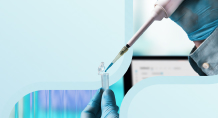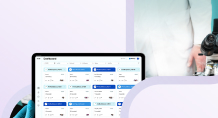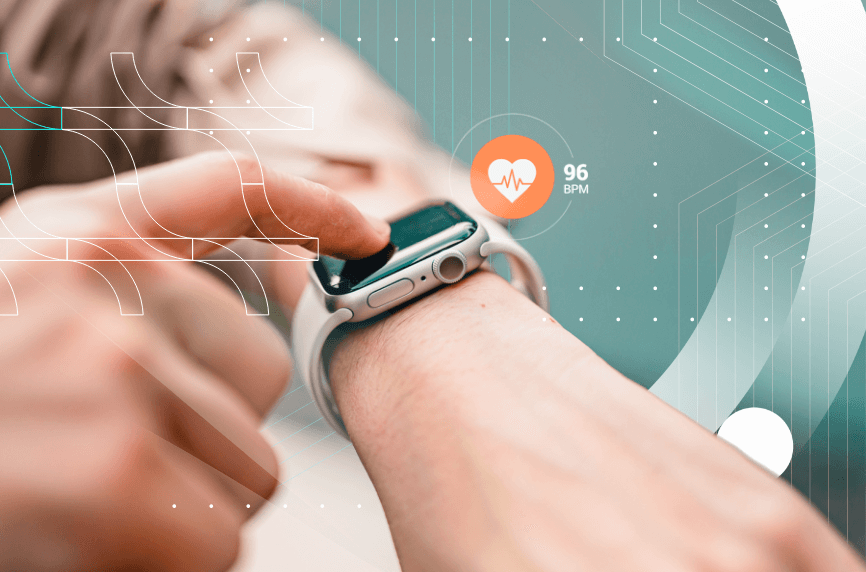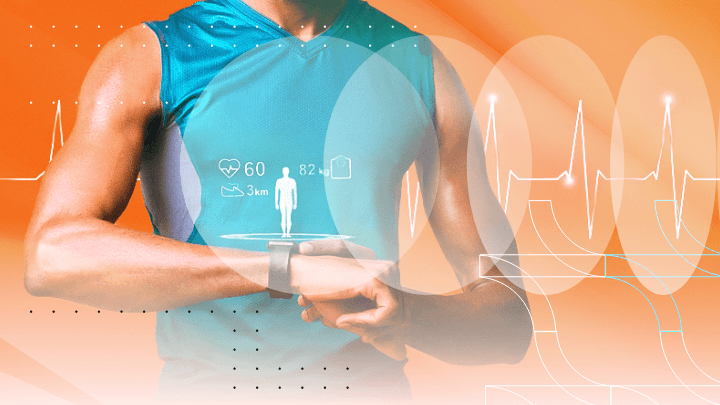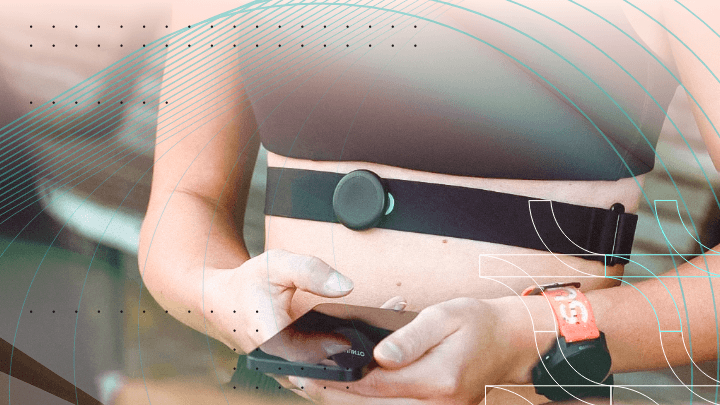The birth of smartphones was the single point at which the whole tech world changed. Nothing in the world of technology has come even close to the impact of their invention since then. GSMA’s sixth annual State of Mobile Internet Connectivity Report states that in 2023 over half (54%) of the global population (4.3 billion people) own such a device. [1]
Smartphones offer the unique capability of connecting everyone to the internet through easily accessible UI. This internet connectivity opens many doors in the world of innovation. One of those doors is the advancement of wearable technology that is connected to the internet and at the same time – collects data.
Wearables are essentially the next big step of everyday cutting-edge tech and their uses in the field of medicine are bound to change healthcare for the better.
This article explores how wearable healthcare technology works, its types, benefits, and the future trends shaping its role in the healthcare industry.
Definition of wearable technology
Wearable technology refers to all consumer electronics designed to be worn on the body. Those devices usually offer functionality by collecting and processing data. In the medical field, it focuses on the continuous tracking of health and fitness metrics.
Unlike traditional medical tools, these devices are lightweight and often integrate seamlessly with everyday life. They include wearable fitness trackers, smartwatches, and specialized wearable medical devices for specific healthcare purposes.
Biosensor technology and software solutions are at the core of wearable technology in health care. A wearable device can collect and analyze data related to physical activity, and vital signs by the use of this tech. For example, wearable ECG monitors detect heart rhythms, while blood pressure monitors track circulatory health.
Wearable health technology serves various purposes. It tracks fitness data for general health improvement, it supports chronic health condition management, it even enables remote patient monitoring. Wearables connect with apps on people’s phones (such as Apple Health) and through their user-friendly interface, allow patients to integrate the wearable data into their overall healthcare journey.
The healthcare industry has embraced wearable electronic devices because of their potential to improve patient outcomes. These devices bridge the gap between healthcare consumers and professionals, as they use real-time data collection that is integrated directly with electronic health records.
This innovation supports a shift toward personalized, data-driven care that enhances efficiency and accessibility for all.
How wearable tech works
The functionality of wearable health technology hinges on its ability to collect and process health data through advanced sensors. The optical signals, accelerometers, and biosensors are built into the devices and through them, the wearable collects the needed information.
These components track key basic parameters:
- Heart rate;
- Respiratory rate;
- Movement data;
- Blood pressure readings;
- Other parameters.
For instance, wearable fitness technology uses optical signals to detect blood flow changes and track fitness data like steps or calories burned. Wearable blood pressure monitors and ECG devices, on the other hand, analyze cardiovascular health and send reports directly to health providers for real-time insights.
Remote monitoring is a key feature of wearable technologies. These devices enable healthcare professionals to monitor health conditions outside of in-person appointments. This offers a seamless way to manage chronic health conditions. Wearable sensors can detect atrial fibrillation or predict health outcomes through an analysis of trends in movement or other vital signs.
Integration with digital health technologies is another critical functionality. Wearable devices often sync with the electronic health records of healthcare providers. They can make use of the new comprehensive insights into patient health, provided by the analysis. These insights empower healthcare professionals to make data-driven decisions. Better decisions lead to improved care delivery and more patient engagement.
With modern wearables, users can also monitor their own health proactively. This way reliance on traditional healthcare systems is reduced. This proactive approach aligns with the global trend toward personalized and preventive healthcare, where wearable tech plays a central role.
Types of healthcare wearables
The types of wearable technology in healthcare vary widely. They address a range of needs from fitness tracking to advanced medical monitoring.
These include:
- Wearable Fitness Technology. Devices like wearable fitness trackers and smartwatches focus on health tracking features like tracking steps and calories. They provide users with actionable insights to maintain an active lifestyle.
- Wearable Medical Technology. These wearable medical devices are designed for healthcare applications. Examples include devices that measure blood pressure, wearable ECG monitors, and devices for remote patient monitoring. They cater to users managing chronic health conditions or recovering from acute illnesses.
- Wearable Safety Technology. Technology that supports vulnerable populations, such as seniors. Fall-detection devices and emergency alert systems ensure safety and prompt intervention when needed.
- Wearable Health Monitoring Devices. These include advanced biosensor-equipped tools like respiratory rate monitors and glucose trackers. They provide real-time healthcare data to healthcare systems and equip professionals with the needed info for early diagnosis and treatment.
The healthcare industry is witnessing rapid growth in new wearable technology, driven by market demand for versatile and accessible devices. These innovations aim to meet the diverse needs of healthcare consumers while supporting healthcare systems in delivering efficient and effective care.
Functionalities and opportunities
Wearable healthcare technology offers extensive functionalities. Those have made it essentially indispensable in the modern healthcare landscape. At their core, these devices monitor health metrics and provide real-time feedback to users and healthcare providers.
One of the most significant opportunities lies in remote patient monitoring. Wearable health monitoring devices collect continuous health data, which healthcare professionals can access remotely. This continuous data flow eliminates the need for frequent in person appointments and enables timely interventions. Wearable blood pressure monitors and ECG devices allow healthcare providers to monitor cardiovascular health and detect anomalies like atrial fibrillation early. An early intervention is crucial in some cases. Timely intervention both improves patient outcomes and reduces costs.
Wearable technologies also integrate seamlessly with electronic health records. This integration streamlines the communication between patients and healthcare providers. Cutting possible miscommunications is crucial. Data entry often takes a lot of precious time in the physician’s workday and that data is not always accurate (due to miscommunication).
Professionals can both save time and better predict health outcomes by combining data from wearable devices with existing healthcare systems. With that data, they can also tailor treatment plans more specifically to individual patients.
Health tracking features in wearable fitness technology support users in maintaining physical activity and tracking progress toward wellness goals. For instance, fitness trackers measure respiratory rate, and calories burned, which motivates users to stay active. Advanced devices like the Apple Watch even track specific metrics like blood oxygen levels and heart rate variability, which further enhances their utility.
Opportunities for innovation continue to grow. New wearable technology incorporates biosensor technology to monitor complex metrics like women’s health indicators and chronic condition management. Additionally, wearable safety technology exemplifies how these devices cater to diverse demographics.
Wearable healthcare technology bridges the gap between preventive care and chronic condition management by providing users with actionable information. This dual functionality ensures its relevance across the healthcare industry.
Benefits of wearables for users
Ultimately, the whole healthcare system exists to ensure better outcomes for users. Wearables are the catalyst that can bring us to the next step in achieving this goal. They are transformative in the sense that they offer solutions that empower individuals themselves to take control of their health.
These devices enhance patient engagement and provide users with tools to monitor their own health and participate actively in their care. This is in stark contrast to the medicine of old, which was fully reactive. Patients had no knowledge of the data behind their conditions and more importantly – the meaning behind the data about their conditions.
Convenience is one of the most immediate advantages of wearables. These devices eliminate the need for constant visits to healthcare providers. Remote monitoring capabilities enable patients to manage chronic conditions or monitor vital signs from the comfort of their homes. Wearable fitness trackers support daily fitness goals, while wearable medical devices track critical metrics like blood pressure readings or heart health. They are essentially an advisor that can tell the users when they have to visit the doctor.
Wearable health technology also fosters proactive healthcare. It helps users to detect early stages of illnesses before symptoms become severe (or even manifest at all). ECG monitors or blood pressure monitors provide timely alerts that allow patients to seek timely intervention when necessary.
Wearable technologies also provide peace of mind for healthcare consumers. Paranoia about one’s health condition can lead to the worsening of that very same health. Wearables fight that paranoia, as they also alert users when everything is within the norm. That can benefit hypochondriac patients both mentally and financially.
The constant flow of reliable information reduces the frequency of in-person appointments, which cuts transportation and in-person consultation costs. Patients can still get the help they deserve through telemedicine. Online appointments were unreliable before, as doctors had to run tests to get a real sense of patients’ conditions – wearables allow patients to do those scans themselves.
Additionally, wearables cut costs in other ways. Early detection can prevent expensive emergency care or hospitalizations by enabling timely intervention. Wearable fitness technology replaces the need for costly personal trainers or gym memberships for fitness enthusiasts.
Tech companies are committed to expanding the capabilities of wearable devices and ensuring they meet the evolving needs of healthcare consumers. Wearable healthcare technology continues to innovate and improve user experience.
Discover how we can help outsource Healthcare projects efficiently Speak to an expert today, and see how our on-demand IT talent and augmented teams can efficiently deliver value at every step of your roadmap.

Future trends in wearable healthcare tech
The future of wearable healthcare technology is promising, with the global market expected to grow exponentially in the coming years. Grand View Research predicts a yearly growth of 14.6% until 2030.[2] The integration with artificial intelligence and expanding applications are going to be the shaping phenomena in the next generation of wearable devices.
Here are some of the major tech trends in wearable medical sensors and devices:
- Integration with AI will enable wearable technologies to analyze even more complex datasets. Following that – they will predict health outcomes better and provide more accurate insights. This shift will enhance remote monitoring, which will allow healthcare systems to deliver 100% personalized care.
- Advanced biosensor technology will expand the range of metrics that wearable devices can track. New devices will cater to a broader spectrum of healthcare needs – from monitoring chronic health conditions to addressing mental health. For instance, future wearables may offer more comprehensive tools for tracking stress levels or even hormone levels. The latter can serve as a useful tool for managing depression or conditions like ADHD.
- Preventive care is sure to be a key focus. Wearable devices are likely to support early diagnosis by analyzing subtle trends in collected data. This will empower patients to take proactive steps toward better health, which will reduce the burden on traditional healthcare systems – a burden that has already become too high. In the UK in November 2021, 10 000 patients waited over 12 hours in emergency departments after a decision to admit to hospital—five times more than in 2020 and nine times more than in 2019. [3] Wearable tech is sure to alleviate this over-encumbrance.
- Tech companies will also explore innovations in design and functionality. Lightweight, user-friendly medical wearables will prioritize comfort while maintaining precision. These devices will appeal to a growing number of healthcare consumers and will drive the market demand for wearable healthcare technology.
As wearable technologies evolve, they will continue to bridge the gap between patients and healthcare providers. With continuous innovation, these devices are poised to redefine how people interact with their health. This will pave the way for a smarter, more connected healthcare system.
This is why wearable tech will remain central to the future of the healthcare industry. Any healthcare company that aims to be competitive ought to integrate wearable solutions in their toolkit. A reliable IT partner is paramount for successful implementation. BGO Software may be exactly what you need.

